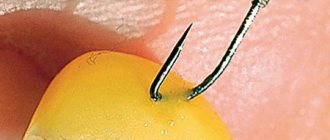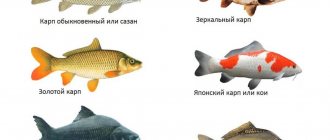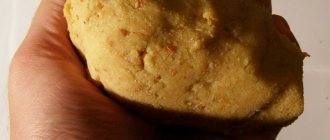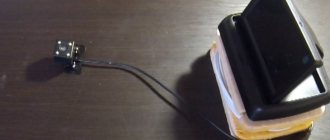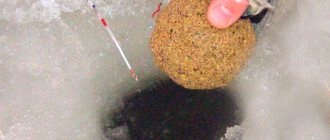What kind of fish can you catch?
Most “white” fish bite on corn, but some species give particular preference to this bait.
Carp and carp
When fishing for carp and carp, feeder gear is used. Several grains are planted at once, which allows you to screen out small fish and catch large specimens. They are excellent mainly for canned corn, as they like its sweet taste and pleasant smell. But they don’t disdain other species; even puffed corn is suitable for fishing.
crucian carp
This is a timid and capricious fish. Often, in a baited area, crucian carp do not bite on canned corn, but show interest in dairy or boiled corn. Corn for fishing for crucian carp is used in the summer, since crucian carp during this period prefers plant bait. At night there is a chance to catch a large specimen of crucian carp.
Chub
This is a river omnivorous fish. When fishing for corn, you should use float and feeder equipment. This fish has no particular preference.
Roach
If there are roaches in the reservoir where you will be fishing, then there is a chance to catch a large specimen of this fish using corn. Large fish bite on any type of grains, but prefer boiled ones.
Tench
It lives mainly in lakes and ponds where there are thick thickets. In the spring, tench begin to take on various plant baits, including corn. In summer, tench do not pay attention to it, but prefer animal baits.
Bream and silver bream
The bite of these fish on corn depends on the water temperature. In summer, only a few specimens are found. Closer to the cold season, when the temperature drops, bream and silver bream begin to actively bite on corn.
Basic cooking rules
The bulk
The easiest way is to buy canned corn at the store.
There is a wide range of ready-to-eat sweet grains on supermarket shelves. Usually canned food is added to salads or they serve as an independent side dish. The first places in terms of grain quality are occupied by “Uncle Vanya” and “Self-assembled tablecloth”.
When purchasing finished products, there may be consequences, for example, corn can be small in size, which is only suitable for catching small fish.
Fishing stores sell special mixtures: dry, canned, semi-finished products. They are of better quality, but the price is much higher. Thus, it produces jars weighing 105 grams. with corn grains of different sizes at a price of 75 rubles.
What flavorings and additives can be used and when?
By adding spices, aromas, and natural dyes, the amount of catch increases. As a complementary food, this will force the fish to pay attention to pronounced odors, stand near it, and try it.
Expert opinion
Knipovich Nikolai Mikhailovich
Zoologist, hydrobiologist. I am interested in fishing at a professional level.
Attention! Closer to summer, it is better to use sweet smells: banana, strawberries, vanilla, cream. If it is the autumn period, then you need to choose ones that taste like shrimp, crayfish, and caviar.
The choice is huge, but it’s cheaper to do it yourself.
Fermented
It is considered the most effective bait for the carp family. Fermented corn has a sour taste and soft texture due to the fermentation process. The cost of its preparation is much lower than its ready-made counterpart. The only drawback is the preparation time, which is about 4-5 days. Pros of Fermented Corn:
- The fish senses the sour smell of the grains and swims more often to the bait.
- The soft consistency allows the fish to feed and not get full, since the fermented grains are quickly absorbed and digested. Therefore, the fish will not leave the feeding place.
Bait recipes
If we talk about the ancestor of carp fish, then the number of recipes suitable for catching it increases noticeably. He loves sweets, and he doesn’t really care what exactly the sweetness gives. It turns out that we can add sugar, honey, fruits and berries, and even candy. Corn seeds will perfectly absorb our flavoring sweeteners and make excellent bait for the "underwater pig".
Soaking and cooking
The recipe is simple, and both dried and fresh seeds are suitable for us. Let's get started:
- Take a container and start soaking the cereal. The process will take 2-3 days, but it is still recommended to keep an eye on it, because the time depends on the variety and harvest.
- They will swell. That's it, cook it in the same water for 30-50 minutes. While cooking, stir, add sugar, cinnamon, vanillin and honey.
- Remove from heat, continue stirring, let cool and brew. The nozzles are ready.
Be sure to check with a hook or a needle: is the corn sitting securely and is it not falling apart?
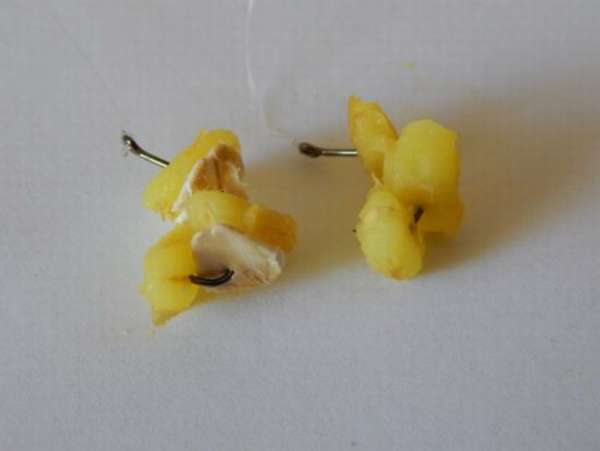
Often fish try to knock baits off hooks with their nose or fins. This is also why they must sit securely.
Steaming in a thermos
More complicated, but more effective. Recipe:
- Soak the grains in warm water. We change it every 2-3 hours, and so on all day. There is no need to change the water at night.
- Now you can steam it. Fill a third of the thermos with soaked grains and pour boiling water over it.
- Add sugar or add another sweetness (fruit, some add chocolate).
- After two hours the nozzles are ready.
Fermentation
Fermentation is a process in which fermentation plays a major role. The grains turn out to be sour; this is perhaps the only exception where carp prefers a sour taste. The smell is bright and rich if everything is prepared correctly.
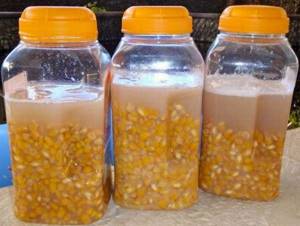
It should ferment only in glass or clay containers! In plastic or metal (without enamel) containers, a chemical reaction will begin. IMPORTANT! But the main advantage of fermented corn is its rapid digestibility in the carp’s stomach! That is, he likes to eat it, but he still cannot become full. These grains can be used to make wonderful bait!
We will describe the most common recipe. Fermenting:
- Take a container and soak the grains for a day.
- We take out the corn and rinse it under running water.
- Now we need to cook it. For every liter of water in the pan, take 1 tablespoon of beet sugar.
- We put it on fire. Cook for about 40-60 minutes, do not forget to stir.
- Ready. Now the water needs to be drained. The contents of the pan will cool down. Now we transfer the corn into a jar. There we pour new water (not from the tap), add aromas and add 10 grams of baker's yeast or a glass of kefir - as long as conditions are created for bacteria.
- Stir, pour a little sunflower or olive oil. Its layer will not allow air to pass through, and you cannot close the jar - it is necessary for fermentation gases to escape. Oil is a kind of valve.
- That's it, we leave our jar in a warm place for 4-5 days - let it ferment and become sour.
You need to drain the water while fishing or take the grains without draining. If you salt it now, a lot of the smell will be lost. We store the stock in the same jar, but in the refrigerator so that our dish does not ferment. Fermented corn for fishing is also found in stores. It is packaged in jars, buckets and large buckets. It can be used as complementary food or placed on a hook; it can even be pushed tightly into a feeder feeder.
Canned strawberries and vanilla
Carps literally flock to this dish. Added to the sweet corn flavor are strawberries and vanilla (diffusing enhancer)! It’s easy to do; all you need is a small glass jar with a lid. Cooking:
- Open an iron can of canned grains. Be sure to taste it! It shouldn’t be bitter, it shouldn’t be too sour. Not enough sweetness - add a teaspoon of sugar.
- Transfer to a glass container along with the juice! We put strawberries crushed with our fingers there; 3-5 medium-sized berries are enough for us.
- Sprinkle in a little vanilla, mix everything thoroughly and put in the refrigerator for 2-3 days.
The nozzles will turn out tasty and aromatic. Why is there carp - a person will appreciate such a dessert! We take a jar with us, and not the corn caught from it - there should be juice throughout the entire fishing. It is better to store in the refrigerator, otherwise it will ferment.
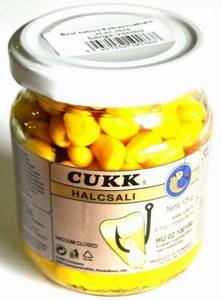
Store-bought fishing baits made from corn can be found in different colors. There are red ones, and there are grains colored green. The fish are used to yellow, it’s better to take the “classics”.
Sweet corn in jars
Sold canned. It is better to purchase it at the market or grocery store. Canned corn has several distinctive features for fishing for the carp family:
- It attracts with its pleasant bright colors, taste and aroma that does not scare away fish.
- Corn kernels hold well on a hook as bait. Small fish cannot knock down or swallow the bait, because of this they bite less often and allow larger fish to approach.
- Canned grains do not need additional preparation; you can immediately go to the pond and fish. It is allowed to add various flavors to increase the likelihood of a bite.

Canned corn
Canned corn is very often used by fishermen recently because:
- It is inexpensive and can be stored for quite a long time in the refrigerator.
- Carp always reacts well to it.
Cons of canned corn:
- In some manufacturers it is very hard and does not fit well on the hook.
- It may be tasteless and not attract fish with its aroma.

The use and selection of suitable canned corn has its own characteristics:
- When purchasing canned corn, you should choose only the hard varieties as they will hold better on the bait.
- The kind of corn that a person likes to taste may not necessarily attract carp.
- It is better to buy canned corn in specialized stores, where flavors and dyes are added to it, which will attract the attention of carp. If you cannot find such corn, then the companies Bonduelle and Vernet are considered the best producers of canned grains, since their product is easily hooked due to its softness and the fish bite well on them.
In order for canned corn to be as effective as possible, the following methods should be used:
- Add a little essence to the grains with the aroma of sweet berries, vanilla, and honey. For catching in the autumn, it is recommended to use flavor enhancers with the aroma of shrimp or meat.
- You can dip each kernel of corn in the flavoring just before putting it on the hook.
- It is advisable to add a flavoring with the same smell that will be contained in the grains to complementary foods.
Young corn (raw) can also be used as bait. As a rule, well-aimed carp readily bite on such grains and do not feel threatened by the smell and taste of the yellow bait. It is important to know that it is young corn or “milk” that can be used, and not just already ripened grains. In addition, it is not advisable to add it to already cooked bait.
As for boiled and fermented corn, we will consider the features of their preparation separately.
Artificial corn
Inedible imitation grains. Made from synthetic plastic. The undoubted advantages are:
- Reusable.
- Add any flavoring.
- Durability of the bait.
- Variability of colors.
Victoria Leshchenko
I've been working hard in the fishing tackle department for the past six years. I can help you assemble almost any gear.
Ask a Question
Sometimes artificial kernels are most often sold in a can with flavoring, but you can buy unflavored corn and add flavoring at your discretion.
Step-by-step instructions on how to cook
Fermented
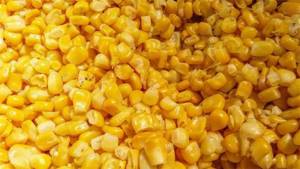
Corn kernels are called "fermented" if they have undergone a fermentation process. When exposed to sugar or lactic acid bacteria, two by-products are formed: ethanol and carbon dioxide.
For this type of nozzle you will need:
- corn grain;
- sweeteners: sugar, molasses, honey, glucose;
- dry yeast;
- vegetable oil;
- 3 liter jar.
Recipe:
- The grain is filled with water and cooked over medium heat for 50-60 minutes.
- It is checked for readiness (if you press on the middle of the grain, it should retain its shape).
- The water is decanted into a separate container.
- The broth is cooled, a sweetener is added.
- A packet of dry yeast (20 g) is stirred into the warm mixture.
- The starter is poured into a container with corn, everything is mixed.
- 1-2 tbsp is poured on top. any vegetable oil.
The lid of the jar does not close tightly. 4-5 days are enough for slow fermentation. The entire process eliminates the influence of light.
Another method is fermentation with kefir. It does not require cooking. The grains are filled with fermented milk products, water, and infused. The fermentation process will take more than a week.
Expert opinion
Knipovich Nikolai Mikhailovich
Zoologist, hydrobiologist. I am interested in fishing at a professional level.
Healthy! If too much has been done, fishing is planned in the coming days, then the remaining grain is left in the bottle for further fermentation.
Sweet corn
Calculation: 0.5 kg of sugar requires 1 kg of corn grain.
- First, the corn is boiled until half cooked, covered with sugar, and boiled for 5-7 minutes.
- The mixture is placed in jars, which are pre-washed with soda solution and steamed.
- Using the sterilization method, jars of corn are immersed halfway in a container of water and boiled for 15-20 minutes. The finished semi-finished product is covered with a varnish lid, rolled up and cooled.
Regular
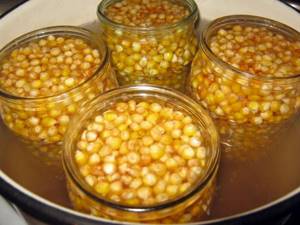
To harvest such corn you need grains, aspirin tablets and water.
- The jars are washed with a soda solution, rinsed, sterilized with steam or in the microwave.
- The corn is washed under running water.
- The grains are poured halfway into the prepared jars.
- Fill with hot water (temperature no higher than 90 degrees).
- The containers are placed in a large tank, with a towel placed at the bottom.
- Water is poured up to the neck of the jar.
- Monitor the water boiling over low heat for 4 hours.
- At the end of the process, 2 aspirin tablets are added to the jar (calculated for a 1-liter container).
- Roll up the lids, turn over, cover with a blanket until completely cool.
This product is stored for a long time, but requires a long time to prepare.
Inedible imitator
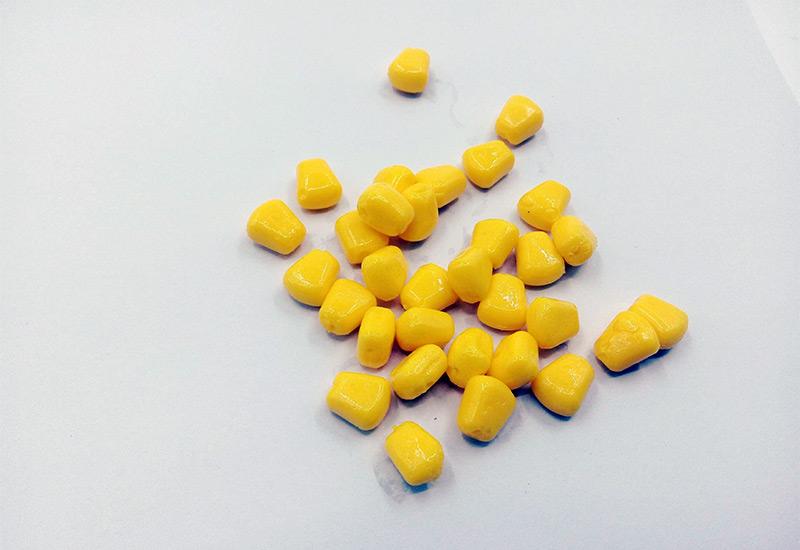
Grain simulators are sold as ready-made baits in specialized fishing stores. They are not edible, but serve as bait for catch. Made of synthetic plastic, artificial flavors and chemicals are used in its preparation. Advantages:
- reusable;
- fast catching effect;
- used when the water is too cloudy or the bottom is muddy.
The price of the products is high, but it is unknown whether the fish will like this “food”.
Branded
Branded corn is virtually identical to canned corn, but is prepared specifically for fishing in order to increase the number of bites. The grains in the jar are large, selected and treated with various flavors. The sugar content is lower than canned corn, so it is more like natural corn. The shelf life is longer than canned, since the manufacturer adds special ingredients to extend it. The price of such a product is several times more expensive than the canned one.

Fermentation
The cooking time for fermented corn is about 4-5 days. Therefore, it is necessary to prepare the so-called drunken corn for fishing in advance.
Recipe:
- Pour hot water over the grains and cook for 40 minutes. Then drain the water and refill with cold water.
- Add 2 tbsp. l. sugar per 1 kg of grains.
- Then add yeast according to the following scheme: 10 g of yeast per 1 kg of corn.
- Pour in sunflower oil to prevent access to air.
- It is not allowed to close the container with a lid, as the outlet of carbon dioxide will be blocked.
Fermentation is carried out to soften the grains. Later, the “drunk” corn is used as bait.
Recipe for fermenting drunken corn for fishing
The classic recipe for fermenting corn involves the presence of the finest grains, yeast and sugar. In practice, when preparing bait of this kind, fishermen often use flavored additives. As a rule, these are products or attractants with sweet odors that can additionally attract fish to the fishing zone. During the fermentation of the ingredients, strawberry, apricot or raspberry jam, honey or molasses are added to them.
Fermentation begins with washing the grain and then soaking it, as a result of which dry and hard corn is saturated with water and swells. After soaking for a day, the grains are cooked over low heat, bringing the broth to a boil for one hour, while adding a little sugar to the water. After cooking, the corn is allowed to cool to room temperature, after which it is filled with sourdough. Sourdough is prepared from a decoction of grains by adding yeast and sugar or another sweet product.
Important! Per kilogram of grain you will need only 10 grams of yeast and a couple of tablespoons of granulated sugar, molasses or jam.
The composition is stirred, resulting in a syrup and poured into boiled grain, poured into a glass container. A quarter of free space is left in the bottle for the collection of gases released during the fermentation process. To remove gases from the container, install a hydraulic seal or put a rubber glove on the bottle with a pierced hole to relieve excess pressure.
Important! If the pressure is not relieved, there is a possibility of the container bursting, which is by no means safe and is fraught with unpleasant consequences.
After three days, the product will go through the fermentation stage and take on the appearance of ready-to-use bait. In the absence of yeast, grain can be prepared using the presented technology, only fermentation will last 3–4 days longer. After fermentation is complete, the juice is drained and the grain is used for its intended purpose, slightly dried at room temperature. The solution can be used as a moisturizer to prepare attractive fishing baits.
Features of preparing corn for carp and carp
Bait in the form of corn increases the likelihood of an active bite, since carp and carp like its taste and smell. Special flavors are added to the cooked grains, cooked by fermentation. To catch carp, you need to add honey or sugar; sweet grains will attract fish more. When fishing for carp, it is recommended to add vanilla, plum or caramel.
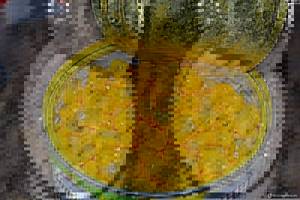
Preparing Fermented Corn
The process for preparing fermented corn for fishing is as follows:
- Dry corn is soaked for about a day.
- Then cook until it begins to knead with two fingers, but remains firm.
- Next, the water is drained from the corn.
- Yeast and sugar are added to the water, all this is stirred and poured back into the corn.
- The flooded corn is infused for 3 to 5 days in a warm place.
Everything seems simple and even elementary. In practice, you most likely won’t succeed the first time. It takes some experience to learn how to prepare the perfect fermented corn that bream, carp, carp and other fish in your area will love.
You can also watch the video on how to prepare fermented corn for fishing.
Tips for catching carp on corn
Successful carp fishing depends not only on the choice of fishing location or how much bait you used, but also on the correct use of the bait. You should know the following:
- You can attach the bait not only by threading it with a hook, but also on the “hair”. When a carp bites, it sucks in the bait along with the hook and won’t come off. Hair fishing is used if you are going to use fermented corn, as it is soft, does not stick well to the hook, and the fish often knocks it off.
- You should not overly feed carp while fishing, as corn is very nutritious, the fish gets full and stops taking bait.
- Fish often notice corn on the bottom, but if fishing is in a silted reservoir, the bait is buried in the silt and the fish cannot find it. To make the bait with the hook rise a little from the bottom, you must also use a foam ball.
- When fishing in autumn and spring, carp are less likely to bite on plant baits. During this season, fish need protein. In order to correct the situation, you should use a “sandwich” - when, in addition to corn, protein bait (maggot, bloodworms or worm) is baited.
- When using canned grains, do not immediately pour out the contents. Syrup can be added to complementary foods; the strong smell will attract more fish.
Correct rig with corn
When fishing for large carp, several grains of corn are used to hide the hook as much as possible.
Our main article on carp rigs . Feeder equipment . Fishing for carp on a feeder .
For carp fishing, flat-method feeder rigs and other open feeders are used. A more detailed description of them can be found in the links above.
Placing corn on a hook.
The main goal is to hide the hook, and if up to four corn can be threaded on large hooks, then on small hooks you need to be more sophisticated.
How to plant?
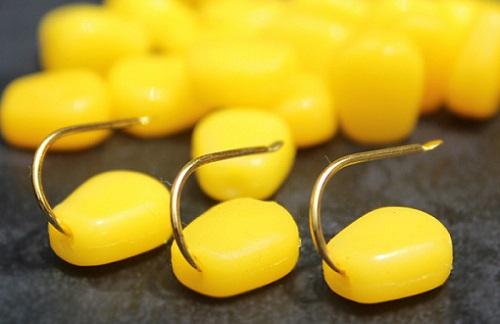
Hair rig
Hair rig is a rig in which the bait is not attached directly to the hook, but to a kind of retractable leash located in close proximity to the hook. Greedily grabbing the corn, the carp does not notice the hook, which hooks the carp by the lip when it tries to spit it out. It is used when fishing for carp with both corn and boilies.
Pros of hair equipment:
- It is considered the most effective equipment for carp;
- Cheap materials;
- Reliability. The connections are covered with tubes, the possibility of using strong node connections;
- Almost one hundred percent guarantee of a carp bite.
Minuses:
- Frequent snags;
- Frequent overlaps;
- Can be difficult to assemble on site.
You will need:
- Heat shrinkable silicone tube;
- Rubber tube (preferably flagship);
- Swivel/quick release;
- Split 0.26 g;
- Pliers;
- Stoppers;
- Hook.
- Braided cord or fluorocarbon.
The cord is braided or fluorocarbon - the length needed is the same as the leash + 10-15 centimeters. That is, for a leash of 20 centimeters, take 35 leash line.
So, let's assemble the hair equipment:
- Fold the fishing line in half and knit a regular knot. Cut off the excess.
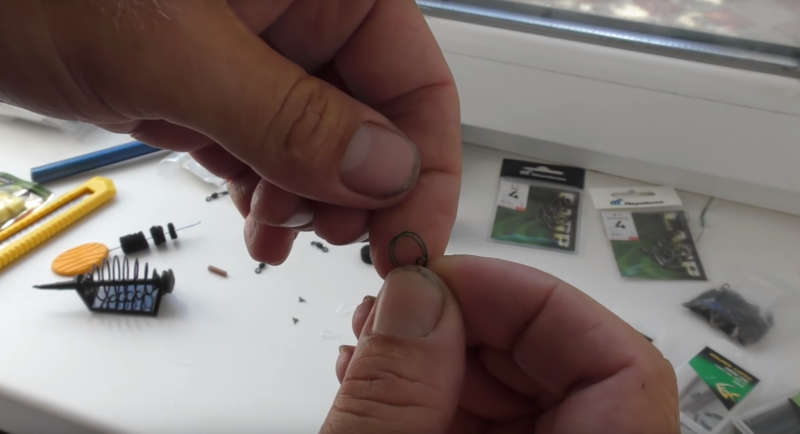
2. We insert a silicone tube to the base of the loop.
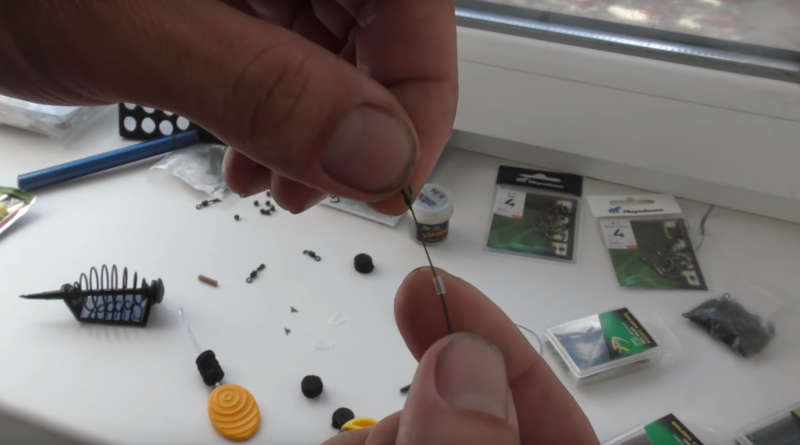
3. Thread the hook through the tube with fishing line.
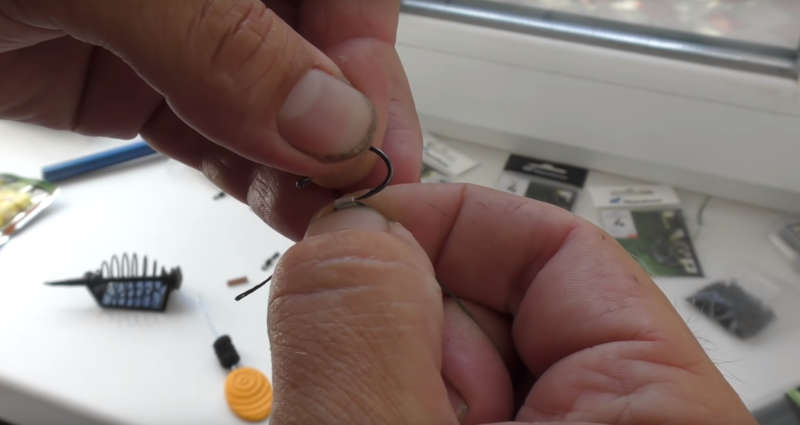
3. This is what should happen.
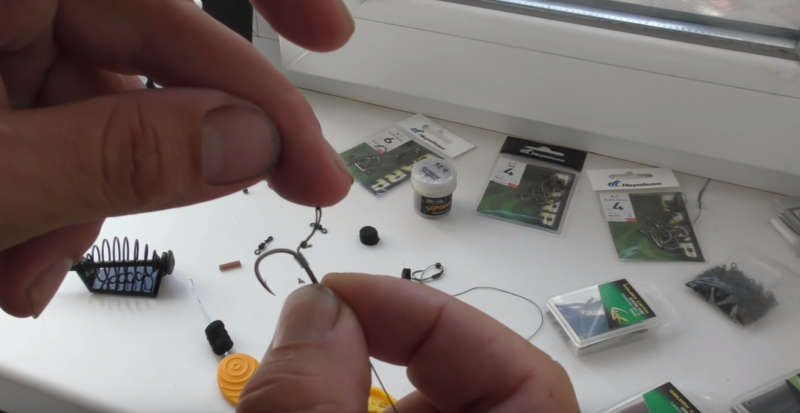
4. We thread the fishing line through the eye and make 10-15 turns around the hook. Then we put it through the eye again.
On the reverse side we also make a knot.
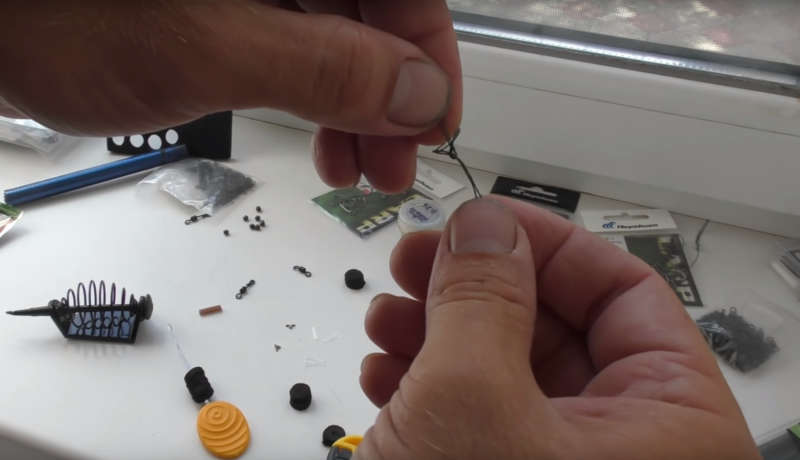
5. Thread a thermofit tube 1 cm long into the fishing line and attach it to the hook. You need to fix it with steam from a kettle, not with a lighter. The fire from the lighter deforms the cord.
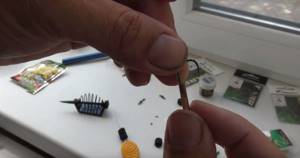
6. After crimping the tube, add the pellet and squeeze it with pliers.

7. Corn or other bait is threaded through the fishing line, and a stopper is threaded at the end of the fishing line. Let's pull it up.
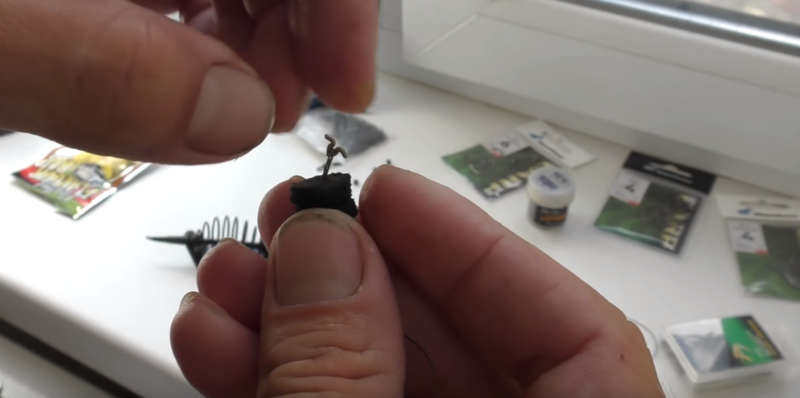
8. We thread the tube, then from the back side and attach the quick release or swivel.
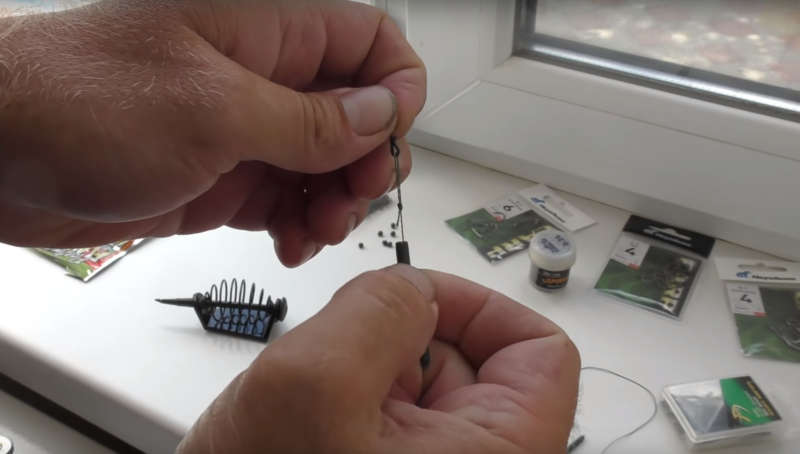
9. Everything is ready! (The picture is missing the crimp tube near the hook, as the pictures were made for clarity.)
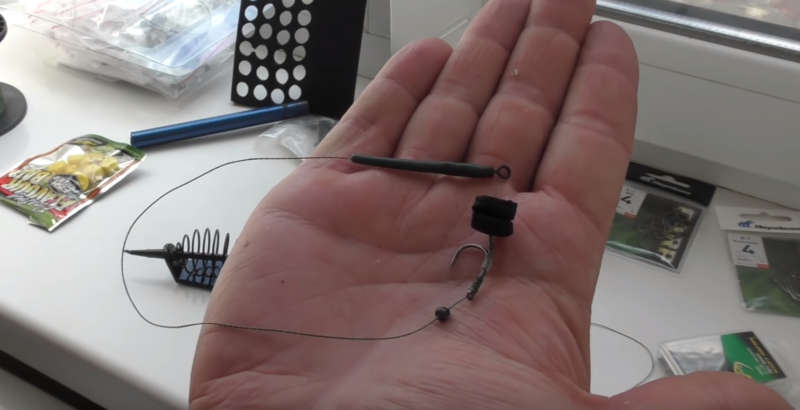
Thanks to Captain Gak for providing the images!
Carp installation of hair equipment - video:
Preparing corn for bait
There are 2 ways to prepare bait:
- Cooking, which is used on rivers with strong currents.
- Steaming is used on stagnant bodies of water or on small rivers.
Cooking for the river
From the prepared mass, balls are formed for feeding fish. When they fall into the water, they fall to the bottom and are washed away by the current of the river, thereby luring fish to one place. Preparation:
- 1 kg of crushed grain is poured with water and cooked over low heat until it boils.
- After the water boils, wait 5-10 minutes, then add 200 g of corn flour and cook for 1 minute.
- The porridge is removed from the heat, 300-400 g of cake and 200 g of flour are added to it. Then everything is mixed and any flavoring is added - anise or dill.
Steaming for a pond
When using bait in still water, you need to form balls and throw them at the intended fishing spot. When fishing on small rivers where there is a current, it is necessary to form balls with the addition of clay. Preparation:
- Pour boiling water over stale bread and cover with a blanket for 2 hours.
- Add 200 g of flour and mix until smooth.
- Mix the resulting mass with corn porridge and stir.
Corn is an excellent bait that is suitable for all bodies of water and for most fish. But you shouldn’t rely on one good bait. Success depends on a large number of factors - gear, choosing a suitable fishing spot and, most importantly, experience.
You can ask your question to our author:
Attaching corn to a hook
Attaching corn to a hook is not very difficult, but at the same time a responsible task, because not only how long the grain will stay on the hook, but the success of the bite as a whole will depend on it.
You can plant one grain or several at once:
Single grain nozzle
To attach only one grain you need to select a small hook. The most suitable numbers are considered to be numbers from 16 to 20.
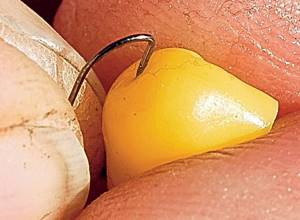
There are many different options for packing one grain, the most effective of which are:
- Piercing the edge of a corn kernel with a crochet hook.
- Piercing the grain through the side to the middle or vice versa.
- Piercing across the grain.
The planting method must be chosen depending on the hardness and size of the grain.
Multi-bean attachment
It is better to place several grains on a larger hook, and you need to pierce it not in the center, but on top of the grain. It is best to thread only the skin so that most of it is free. This will provide the opportunity to thread the maximum number of grains (from 5 to 8 pieces).
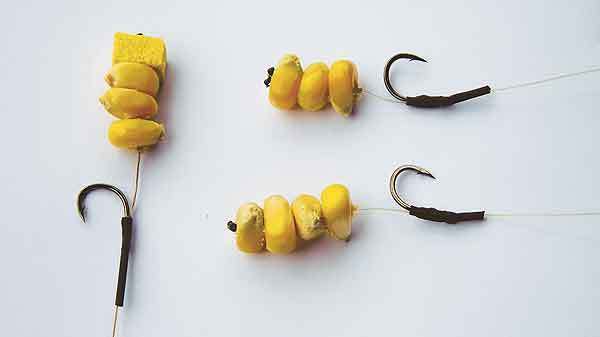
Hair rig. The design of the hair equipment serves the following purposes:
- Allows you to avoid putting corn kernels on a hook, from which they can fly off when casting.
- Such equipment causes less suspicion among carp, since it does not contain a metal hook.
To make hair accessories you will need:
- Hook size 4 to 8.
- Fishing line.
- Leash without knots or twists.
- Silicone tube.
- Mounting needle.
- Plastic stoppers – 2 pcs.
- Cut a piece of fishing line (20-25 cm) and make a loop at its end.
- Thread this loop into the hook, leaving 3-4 cm between the edge of the hook and the end of the loop.
- Using an installation needle, thread the silicone tube (5 mm) through the shank of the hook to prevent the hair from bending.
- Pull the leash through the silicone tube.
- Attach the hook to the fishing line and make a knot from the loop.
- Place stoppers on the loop to prevent the bait from slipping off the hair.
To hide the hook point or not. There is no need to hide the hook tip, since the skin of corn kernels is quite dense and for effective hooking you need to leave at least the tip of the hook bare. Some fishermen think that if you leave the point of the hook uncovered, the fish will prick itself on it and swim away, but as practice shows, this does not happen, and besides, on most baits it is customary to leave the point of the hook open.
The number and size of grains on the hook depends on the size of the hook and the type of tackle:
- When fishing for carp on a feeder, hooks from 4 to 8 numbers can fit up to 7 corn grains.
- You should not put grains of the same size on the hook, as this may make the fish suspicious. Let them be different.
- Threading the grains also does not cost the same amount. For example, through the center or through the edge of the grain.
- When catching small carp, even one grain of corn is enough.
Most often, corn grains are combined with the following attachments:
- Worms.
- Maggots.
- Nozzle made of maggot and corn. To make such a “sandwich” from baits, you need to thread 203 maggots onto the hook, then one grain of corn and then add one or two more maggots on top. Such a bait will attract the attention of the fish and increase the chances of a bite, because there will be two of the carp’s favorite delicacies there at once.
- Worm and corn bait. This general attachment works at any time of the year, so you can’t argue with its effectiveness. To make it, you need to put 1-2 grains of corn on a hook, and then attach 2 large earthworms to the hook. It is also necessary to try to ensure that part of the worm remains free and can move in the water, which will lure the carp even more.
